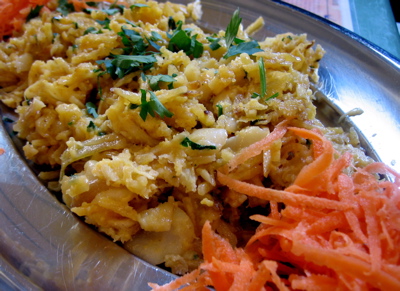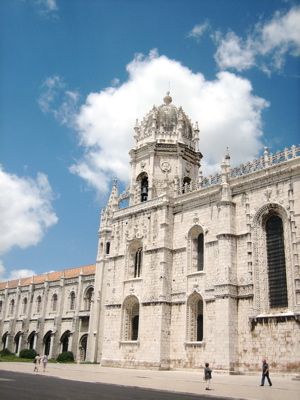Eating in Lisbon was generally cheap and good, though the simplest food turned out to be the best food. Fresh meats and fish, grilled or stewed, dominated our meals. Pastries, including, of course, the egg custards (pasteis de natas) were everywhere, and oddly, chocolate mousse seemed to be the dessert of choice at many of the restaurants we tried.
The cover charge system was a little unusual in that every restaurant starts you off with rolls and cheeses, but if you don’t want to pay the 1 or 2-euro per person cover charge, you just don’t touch the rolls and cheeses. The restaurant then takes them back and presumably serves them to someone else. I wonder if this means there are breads and cheeses that get recycled for days at a time before an unsuspecting diner eats the stuff.
We tried a variety of wines from the Alentejo region of Portugal, and I was consistently impressed by the syrah. Although I’m no expert on wine, I was surprised that I’d never heard anything at all about Portuguese wines, because the ones we tried were generally very good. Maybe wine exporting is all about marketing.
Below are my notes on the places we ate, from my favorite to least favorite:
Nariz do Vinho Tinto (“the Red Wine Nose”) is in the Lapa district of Lisbon, which means it’s in a “nice” (think Embassy Row) but deadly quiet neighborhood at night. We loved this restaurant, and I wished we’d found it earlier in our trip so we could’ve eaten there more than once. We went after reading a 2002 New York Times review describing it as the venture of a food magazine editor, but when we arrived at the restaurant, we were struck by how disorganized and informal the operation was. The maitre d’/server/restaurant owner were the same guy on the evening we ate there, and he looked a lot like Richard Kind (the guy who was on Spin City).
Only after we finished dinner did we learn that (1) the food magazine editor had died years ago, (2) the restaurant had gone downhill, and (3) the current owners (our maitre d’/server and his brother) were trying hard to revive the place’s quality and reputation. The food was well-prepared, delicious traditional Portuguese food, and the service was friendly and welcoming. Definitely give this place a try when next you’re in Lisbon.
The muzak at the beginning of our meal was mildly irritating, but as the courses arrived at our table, we were increasingly thrilled. The only “miss” of the evening was my asparagus and eggs starter, which could’ve been a lot fluffier and creamier, and at 12.50 euros, it wasn’t cheap. Otherwise, the food was simple and delicious. The black-hoofed ham (pata negra) was incredible. Its deep burgundy color made me doubt its deliciousness (I thought it looked too dry), but in fact it was tender, meaty and marbled just so. The portion was large enough to share among the four of us, so well worth the 14 euros.
My main course of grilled, tender goat was excellent. A million times better than the supposedly grilled meat I’d eaten at Pap Acorda (see below). Jon’s hare with a side of rice in a red wine sauce was also hearty and delicious. The hare had been braised for 24 hours and was falling off the bone, and the portion size was beyond generous, arriving at the table in a dutch oven. Ray’s game sausage was packed with herbs, meat and breacrumbs – more like a meatloaf. Kate’s battered-and-fried whole baby sea bass was also simple, fresh and good, and its accompanying “tomato rice” was a good match.
We enjoyed the 2002 Cortes de Cima syrah and downed two bottles of this bold, rich red with that hint of cherry I love so much. As the evening wore on, the other diners left and the muzak was replaced with fado music. Much better. Our host graciously let us stick around for as long as we wanted and kept pouring us several glasses of Kopce 2003 Vintage port on the house. The port was dangerously smooth and sweet, and it was the perfect way to end a great meal.
A Buica: In the heart of the Alfama, the oldest surviving neighborhood in Lisbon. Delicious food, great service. Décor was fun and eclectic – a fado shawl here and there, shelves with music-related bric a brac everywhere. My grilled dorado was outstanding, fresh and just a little bit charred from the grill. Throw on the sea salt, olive oil and lemon, and voila, a filling and delicious lunch. Jon and Ray both tried the restaurant’s bacalhao a bras (photo above), which is a Portuguese comfort food dish much like a hash, and even though I can’t get excited by the ubiquitous salted cod, it’s not bad when mixed in with onions, eggs and potatoes. All the main courses here were generous and less than 10 euros, so for a simple, good lunch in the Alfama, it’d be tough to beat A Buica.
Olivier: On a rainy Friday evening, Kate, Ray, Jon and I arrived at Olivier for our 10 pm reservation. The restaurant was so packed that when the front door swung inward, it hit several people who were crowded in the restaurant’s tiny foyer. The maitre d’ was friendly but couldn’t find our reservation, so we ordered a few glasses of white port and Portuguese wine and huddled by the door, hoping the restaurant could find us a table.
We were eventually seated, and other than being repeatedly asked when and how we made our reservations (subtext: are you sure you made a reservation?), the meal was hearty and overall good.
There’s only one prix fixe menu available (a few customisations are offered for the main meat course), and even though we had aperitifs, nine courses and two bottles of local wine, the $170 per couple price tag seemed a little high for what we ate.
A few of the courses stretched the limits of what counts as a course (e.g., one tortilla chip each, topped with crabmeat and guacamole), and while the wood-paneled decor of the place felt very old-fashioned Portuguese, the food had a very international, random theme to it. There was tomato and a haloumi-like cheese on skewers, (flavorless) octopus carpaccio, thick mushroom soup served in a trendy martini glass, puff pastry stuffed with feta and honey; osso buco, and molten chocolate cake.
Ironically, the foods I enjoyed the most (i.e., the osso buco and the pastry stuffed with feta and honey) weren’t Portuguese, and the authentic Portuguese dish of pork loin from the black-hoofed pig was served crusty and tough, as if it’d been under a heat lamp for the past few days.
Complimentary grappa was served when we got the bill, and it turns out grappa all around the world is strong as all get out.
Overall, service was friendly, the atmosphere was warm and buzzing, and the food was more good than bad. Worth a visit, but go elsewhere if you want a traditional Portuguese meal.
Restaurant Bonjardim serves hot, fresh, rotisserie chicken. The secret to the restaurant’s success appears to be high turnover, which means chickens don’t sit around drying out. For 50 euros, the four of us gorged ourselves on spit-roasted chickens with all kinds of side dishes and drinks. The restaurant has pleasant outdoor seating just off the busy tourist trail of the Avenida da Liberdade, so for a tasty, cheap, relaxing lunch, you could do a lot worse than Bonjardim.
Pap’Acorda, Rua Atalaia. Pap’Acorda is one of those restaurants that had rave reviews in everything from our guidebook to the New York Times. Genre of food? Trendy Portuguese. Hipster neighborhood (Bairro Alta), check. Well-dressed diners, check. Servers with attitude, check. Definitely a too-cool-for-school kind of place, and the food was so-so. If you really want to see what the fuss is about, just stick with the appetizers, which were generally better than the main courses.
About the decor, there’s an annex to the pretty main dining room that lacks character and warmth, so avoid the annex if you can, and as for the service, I was immediately put off when our server insisted that if we drank tap water instead of bottled water, he would not be responsible for our having to use the toilet all night. What a gross thing to say. It was like he threw a hissy fit because we didn’t want to buy bottled water. I don’t know about you, but I expect a little more graciousness when I eat out. The guy’s attitude left me wanting to leave the restaurant right away, rather than, say, linger over another bottle of wine or coffees. So if his objection to tap water is that he can’t make money off of it, then he should seriously reconsider his calculation.
My softshell crab appetizer (caranguejo casca mol) was 14 euros and tasted fresh, but the batter was so thick and dense that it peeled off from the crab like armor instead of adding an extra nice crunch. Kate’s salad served with a chevre button that had been lightly battered and fried was more successful than my crab. It was an interesting and tasty thing to do with goat cheese – a fancy fried cheese.
Feeling that I should give the famous black-hoofed pork a try, I ordered pork chops that were horrendously dry and tough. The saving grace of our meal was a 29-euro bottle of Esporao syrah from the Alentejo. Overall, the tab was 161 euros for appetizers, mains and a bottle of wine shared by the four of us. Not a bad total, but unacceptable for such so-so food.
Notes on three bar/cafes we tried:
Les Mauvais Garcons (39, Rua da Rosa) was our bar discovery of the trip. It’s a small, cozy bar/cafe in the Bairro Alto not far from the Gloria Funicular. We loved the service, which was friendly and knowledgeable, and we especially loved the deep leather armchairs and the strong caipirinhas.
Bar Cerca Moura, 4, Largo das Portas do Sol, right next door to the Museum of Portuguese Decorative Arts and across the street from a stone terrace with stunning views of the ocean and the Alfama district (a miradoura). As if the location weren’t enough, the Bar Cerca Moura has sunny, outdoor seating and a surprisingly sleek and modern interior (surprising because the café appears to be housed in an old stone cave that’s been updated with leather banquettes and steel fixtures). The moist, lemon poundcake gets special mention, though of course you can find strong coffee and Lisbon’s famous natas here, too.

Cafe a Brasileira is the single-most-cited café in every guidebook or travel article about Lisbon, which explains the crowds of guidebook-toting customers. Definitely tourist territory. The ornate ceilings and walls are described as great examples of Manueline architecture (not having any knowledge of Manueline architecture, I can neither confirm nor deny this claim), and if you can get a seat at the cafe, the drinks are surprisingly not expensive. It’s a nice place to take a break if you’re shopping in the Baixa neighborhood, and the cafe is well positioned so you can monitor the traffic at the Hermes store across the street.















